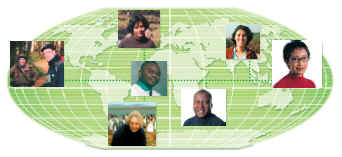Really, I don’t want to talk about me when the world is melting down, but I have had a number of requests for an informal explanation of what I got you-know-what for. So here’s an attempt.
It’s really about two related things: the “new trade theory” and the “new economic geography.”
OK, so what was the “old” trade theory? It’s what you probably learned if you took intro economics. Countries are different – they have different levels of productivity in particular industries, they have different resources, and those differences drive trade. Tropical countries grow and export bananas, temperate countries grow and export wheat. Countries with highly educated workers export high-tech goods, countries with less educated workers export shirts and pajamas.
The new trade theory starts with the observation that while this explains a lot of world trade, it also misses a lot. France and Germany sell lots of stuff to each other, even though they have similar climates and resources; so do the United States and Canada. What’s that about?
The answer is that there are many goods that aren’t like wheat or bananas, but are instead like wide-bodied jet aircraft. There are only a few places in which wide-bodied jets are produced, because of the enormous economies of scale – you only want a couple of factories worldwide. Those factories have to be somewhere, and those countries that get the factories export jets, while everyone else imports them.
But who gets the aircraft factories, or the factory producing a specialized kind of machine tool, or the plant producing a particular model of car that selected consumers all over the world want? The answer of new trade theory – and it was a tremendously liberating answer – is that it doesn’t matter. There are many economies-of-scale goods; everyone gets some of them; and the details, which may be largely a story of historical accident, aren’t important.
What matters, instead, is the overall pattern of trade: the broad pattern of what countries produce is determined by things like resources and climate, but there’s a lot of additional specialization due to economies of scale, and there’s much more trade, especially between similar countries, than you would expect from a purely resource-based theory.
You may think all this is obvious, and it is – now. But it was totally not obvious before 1980 or so – except for some prescient quotes from Paul Samuelson, you really can’t find anyone describing trade this way until after the theory had been laid out in mathematical models. The plain English version came later.
And you should bear in mind that economists have been thinking and writing about international trade for a couple of centuries; to come along and say, “Hey, we’ve been missing half the story” was a pretty big thing.
Now, on to geography. A decade after the original new trade stuff, I started thinking about what happens when some (but not all) economic resources, especially labor and capital, can move. In the world of the old trade theory, “factor mobility” was a substitute for trade: if factories and industrial workers can move freely, they’ll spread out to be close to the farmers, and neither food nor manufactured goods will have to be shipped long distances. But in the economies-of-scale world I had been studying, the “centrifugal” effect of widely dispersed resources, which tends to push economic activity into spreading out, would be opposed by the “centripetal” pull of access to large markets, which tend to promote concentration of economic activity.
Think of Henry Ford and his Model T. He could have established many factories, spread across the country, to be close to his customers. Instead, however, he found that it was worth incurring extra shipping costs to achieve the economies of scale of one big factory in Michigan.
And once you’re concentrating production in a limited number of locations, which locations will you choose? Locations where there’s a large market – which will be locations where lots of other producers have also chosen to concentrate their production. If the centripetal forces are strong enough, you’ll get a cumulative process: regions that for historical reason have a head start as centers of production will attract even more producers, becoming the economic “core” while other areas become the “periphery.” Thus for about a century, until the rise of the Sunbelt, the great bulk of U.S. manufacturing was crammed into a fairly narrow belt from New England to the inner Midwest; today, 60 million people live along a narrow stretch of the East Coast. Those 60 million people aren’t there because of the scenery; each of them is there because the other 60 million people are also there.
The same sort of logic explains why particular industries concentrate in certain locations, except that in such cases the logic involves things like a deep labor market for specialized skills and a good market for suppliers of specialized inputs. What determines which industry locates where? Often, accident: Silicon Valley owes its existence in large part to a couple of guys named Hewlett and Packard, who started some stuff in their garage, New York is New York because of a canal that only pleasure boaters use today.
Again, this may seem obvious, and it is now – but it wasn’t before 1991 or so. As with trade, the plain English version was possible only after the mathematical models had been worked out.
You may ask, where’s the policy implication of all this? Actually, the policy morals are fairly subtle – for example new trade theory does suggest a possible role for government interventions, but also suggests bigger gains from trade liberalization. Mainly my work in trade and geography was about understanding the world, not driving a political agenda.
So that’s what it was all about.
Add: Requests for public domain copies of the key papers cited. Here’s the 1980 paper; here’s the 1991 paper. Both pdf.



